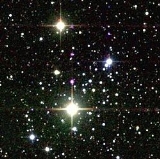
Messier 103
Encyclopedia
Messier 103 is an open cluster
where a few thousand stars formed in the constellation
Cassiopeia
. This open cluster was discovered in 1781 by Charles Messier
’s friend and collaborator Pierre Méchain
. It is one of the most distant open clusters, with distances of 8,000 to 9,500 light years from the earth
and ranging about 15 light years apart. There are about 40 member stars within M103, two of which have magnitudes 10.5, and a 10.8 red giant, which is the brightest within the cluster. Observation of M103 is generally dominated by the appearance of Struve 131, though the star is not a member of the 172-star cluster. M103 is about 25 million years old.
and 103 in 1781, Messier himself had no occasion to carry out more detailed observations of these clusters and included them as a last-minute addition to his catalogue using the data of Méchain. In 1783, William Herschel
observed M103 and described the region as 14 to 16 pL (pretty large stars) and with great many eS or extremely faint ones. Åke Wallenquist
then identified 40 stars in M103 while Antonín Bečvář
raised the number to 60. Subsequently Archinal and Hynes determined that the cluster had 172 stars. Admiral William Henry Smyth
was the first to see the 10.8-magnitude red giant, citing the double star on Cassiopeia’s knee, about a degree to nf of Delta.
Open cluster
An open cluster is a group of up to a few thousand stars that were formed from the same giant molecular cloud and have roughly the same age. More than 1,100 open clusters have been discovered within the Milky Way Galaxy, and many more are thought to exist...
where a few thousand stars formed in the constellation
Constellation
In modern astronomy, a constellation is an internationally defined area of the celestial sphere. These areas are grouped around asterisms, patterns formed by prominent stars within apparent proximity to one another on Earth's night sky....
Cassiopeia
Cassiopeia (constellation)
Cassiopeia is a constellation in the northern sky, named after the vain queen Cassiopeia in Greek mythology, who boasted about her unrivalled beauty. Cassiopea was one of the 48 constellations listed by the 2nd century Greek astronomer Ptolemy, and it remains one of the 88 modern constellations today...
. This open cluster was discovered in 1781 by Charles Messier
Charles Messier
Charles Messier was a French astronomer most notable for publishing an astronomical catalogue consisting of deep sky objects such as nebulae and star clusters that came to be known as the 110 "Messier objects"...
’s friend and collaborator Pierre Méchain
Pierre Méchain
Pierre François André Méchain was a French astronomer and surveyor who, with Charles Messier, was a major contributor to the early study of deep sky objects and comets.-Life:...
. It is one of the most distant open clusters, with distances of 8,000 to 9,500 light years from the earth
Earth
Earth is the third planet from the Sun, and the densest and fifth-largest of the eight planets in the Solar System. It is also the largest of the Solar System's four terrestrial planets...
and ranging about 15 light years apart. There are about 40 member stars within M103, two of which have magnitudes 10.5, and a 10.8 red giant, which is the brightest within the cluster. Observation of M103 is generally dominated by the appearance of Struve 131, though the star is not a member of the 172-star cluster. M103 is about 25 million years old.
Observation history
After the discovery of Messier 101, 102Messier 102
Messier 102 is a galaxy listed in the Messier Catalogue that has not been identified unambiguously. Its original discoverer Pierre Méchain later said that it was a duplicate observation of Messier 101, but there are historical and observational reasons to believe that it could be NGC 5866,...
and 103 in 1781, Messier himself had no occasion to carry out more detailed observations of these clusters and included them as a last-minute addition to his catalogue using the data of Méchain. In 1783, William Herschel
William Herschel
Sir Frederick William Herschel, KH, FRS, German: Friedrich Wilhelm Herschel was a German-born British astronomer, technical expert, and composer. Born in Hanover, Wilhelm first followed his father into the Military Band of Hanover, but emigrated to Britain at age 19...
observed M103 and described the region as 14 to 16 pL (pretty large stars) and with great many eS or extremely faint ones. Åke Wallenquist
Åke Wallenquist
Åke Anders Edvard Wallenquist was a Swedish astronomer. He worked at the Dutch Bosscha Observatory in Indonesia between 1928 and 1935, and became assistant professor at Uppsala's Kvistabergs Observatorium in 1948...
then identified 40 stars in M103 while Antonín Bečvář
Antonín Bečvář
Antonín Bečvář was a Czech astronomer who was active in Slovakia. He was born in Stará Boleslav. Among his chief achievements is the foundation of the Skalnaté Pleso Observatory and the discovery of the comet C/1947 F2 .Bečvář is particularly important for his star charts: he led the compilation...
raised the number to 60. Subsequently Archinal and Hynes determined that the cluster had 172 stars. Admiral William Henry Smyth
William Henry Smyth
William Henry Smyth was an English sailor, hydrographer, astronomer and numismatist.-Private Life:...
was the first to see the 10.8-magnitude red giant, citing the double star on Cassiopeia’s knee, about a degree to nf of Delta.

